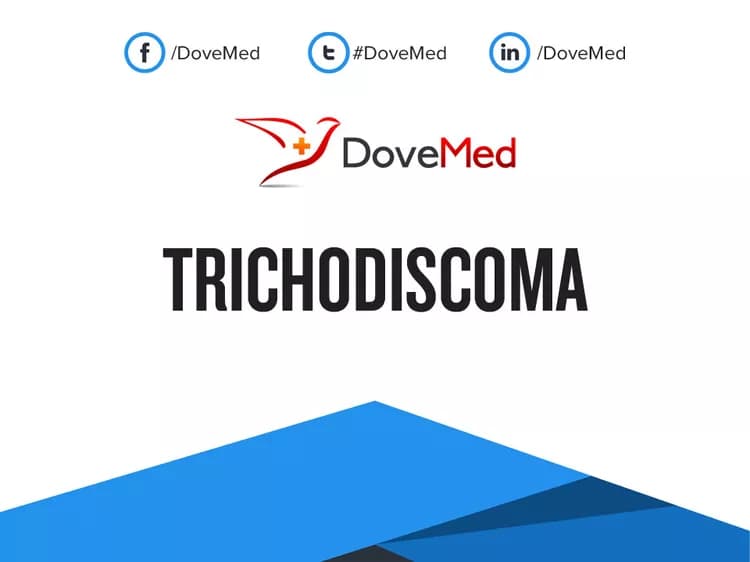What are the other Names for this Condition? (Also known as/Synonyms)
- Multiple Trichodiscoma
- Solitary Trichodiscoma
What is Trichodiscoma? (Definition/Background Information)
Trichodiscoma and Fibrofolliculoma are both hamartomatous tumors arising from hair follicles. Both tumors are considered to be the same. During early stages of development it is termed a Fibrofolliculoma; but during the later stages, it is considered to be Trichodiscoma.
- Trichodiscoma is a rare, slow-growing, and usually benign tumor of the hair follicles. It is generally observed in young and middle-aged adults
- It is associated with Birt-Hogg-Dubé syndrome, a rare genetic condition that leads to the formation of benign tumors of the skin in large numbers
- Trichodiscoma typically does not present any major signs and symptoms. Often, multiple tiny papules may be observed on the head and neck region
- In a majority of cases, no treatment is necessary, unless it causes severe signs and symptoms or presents cosmetic concerns (i.e., it may be visually unappealing)
- The prognosis of Trichodiscoma is generally good with suitable treatment, though it is also based upon the course of the underlying disorder (Birt-Hogg-Dubé syndrome)
Who gets Trichodiscoma? (Age and Sex Distribution)
- Trichodiscoma is a rare skin condition that is observed in 20-50 year adults
- Both males and females may be affected
- Individuals of all racial and ethnic background may be affected. Worldwide, no geographical localization of Trichodiscoma has been reported
What are the Risk Factors for Trichodiscoma? (Predisposing Factors)
The following risk factors have been identified for Trichodiscoma:
- Birt-Hogg-Dubé syndrome (BHD syndrome): It is a hereditary disorder that is characterized by numerous tiny follicles on the skin. This rare condition also affects the kidneys and lungs
- Currently, no other predisposing factors are known for Trichodiscoma
It is important to note that having a risk factor does not mean that one will get the condition. A risk factor increases ones chances of getting a condition compared to an individual without the risk factors. Some risk factors are more important than others.
Also, not having a risk factor does not mean that an individual will not get the condition. It is always important to discuss the effect of risk factors with your healthcare provider.
What are the Causes of Trichodiscoma? (Etiology)
- The cause of development of Trichodiscoma is largely unknown
- Research is currently being undertaken to identify the relevant causal factors
What are the Signs and Symptoms of Trichodiscoma?
Trichodiscoma is typically asymptomatic, indicating that they do not present any significant signs and symptoms. However, the following features may be observed:
- It can occur as a solitary or multiple papules on the skin; usually there are multiple skin lesions
- It is a slow-growing tumor with an average size of 1-3 mm
- The papule is usually painless and non-itchy
- It can occur anywhere in the body, but they are commonly observed in the head and neck region (especially on the face), also on the arms, thighs, and trunk
- Trichodiscoma can be sometimes confused with basal cell carcinoma (a malignant skin tumor), because of their appearance
Both Trichodiscoma and Fibrofolliculoma have similar appearance and presentation. However, when examined under a microscope by a pathologist through a biopsy, both have different features.
How is Trichodiscoma Diagnosed?
A diagnosis of Trichodiscoma may involve the following:
- A thorough medical history and physical examination
- Dermoscopy: It is a diagnostic tool where a dermatologist examines the skin using a special magnified lens
- Wood’s lamp examination: In this procedure, the healthcare provider examines the skin using ultraviolet light. It is performed to examine the change in skin pigmentation
- Skin biopsy: A skin biopsy is performed and sent to a laboratory for a pathological examination. The pathologist examines the biopsy under a microscope. After putting together clinical findings, special studies on tissues (if needed) and with microscope findings, the pathologist arrives at a definitive diagnosis
Note: A biopsy may be performed, since sometimes the tumor resembles basal cell carcinoma.
Many clinical conditions may have similar signs and symptoms. Your healthcare provider may perform additional tests to rule out other clinical conditions to arrive at a definitive diagnosis.
What are the possible Complications of Trichodiscoma?
- However, some individuals may have concerns regarding their cosmetic appearance, especially if it occurs on the face
- If the tumor is associated with Birt-Hogg-Dubé syndrome, then the complications of the syndrome may be noted
How is Trichodiscoma Treated?
The treatment of Trichodiscoma may involve the following:
- The healthcare provider may recommend a ‘wait and watch’ approach in many cases
- In a majority of cases, a surgical removal of the tumor is not necessary, unless it causes bothersome signs and symptoms
- A complete surgical excision is mostly performed for cosmetic reasons
- Evaluating for the presence of, and treating any underlying disorders, such as Birt-Hogg-Dubé syndrome, is important
How can Trichodiscoma be Prevented?
Currently, there are no known methods to prevent Trichodiscoma occurrence.
What is the Prognosis of Trichodiscoma? (Outcomes/Resolutions)
- The prognosis for Trichodiscoma is excellent with appropriate treatment, since it is a benign tumor
- However, the prognosis may be dependent upon the severity of the underlying condition (if any present)
Additional and Relevant Useful Information for Trichodiscoma:
- There is no evidence to prove that oily foods and chocolate-based products have an influence on Trichodiscoma formation
- Cleaning the skin too hard with strong chemicals or soaps may aggravate the skin condition. Care must be taken avoid strong soaps and chemicals that could potentially worsen the condition
- The presence of dirt on the body is not a causative factor for the condition. However, it helps to be clean and hygienic, which may help the condition from getting worse
Related Articles
Test Your Knowledge
Asked by users
Related Centers
Related Specialties
Related Physicians
Related Procedures
Related Resources
Join DoveHubs
and connect with fellow professionals



0 Comments
Please log in to post a comment.